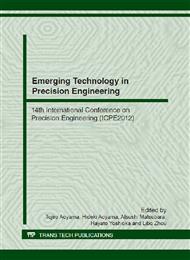p.445
p.451
p.457
p.463
p.469
p.475
p.481
p.487
p.493
Concept for Temperature Control in Broaching Nickel-Based Alloys
Abstract:
In production of safety critical components in aero engine manufacture, to date broaching is the most efficient process machining fir-tree slots in turbine discs. Machining highly thermal resistant Nickel-based alloys, manufacturers commonly use High Speed Steel (HSS) tools and work at low cutting speeds in order to stay at rather low tool wear rates and avoid part quality defects. The key variable affecting tool wear as well as part quality, as in most machining processes, is the temperature. Excessive temperatures in the cutting zone lead to enhanced tool wear on the one hand, and surface defects such as white layer formation and residual tensile stresses on the other hand. In this article, the temperature development is investigated for typical tool geometries and cutting parameters in broaching. Furthermore, the possibility of a temperature control using intermediate variables such as process forces is discussed, and potentials employing a control are explained.
Info:
Periodical:
Pages:
469-474
Citation:
Online since:
November 2012
Authors:
Keywords:
Price:
Сopyright:
© 2012 Trans Tech Publications Ltd. All Rights Reserved
Share:
Citation:


